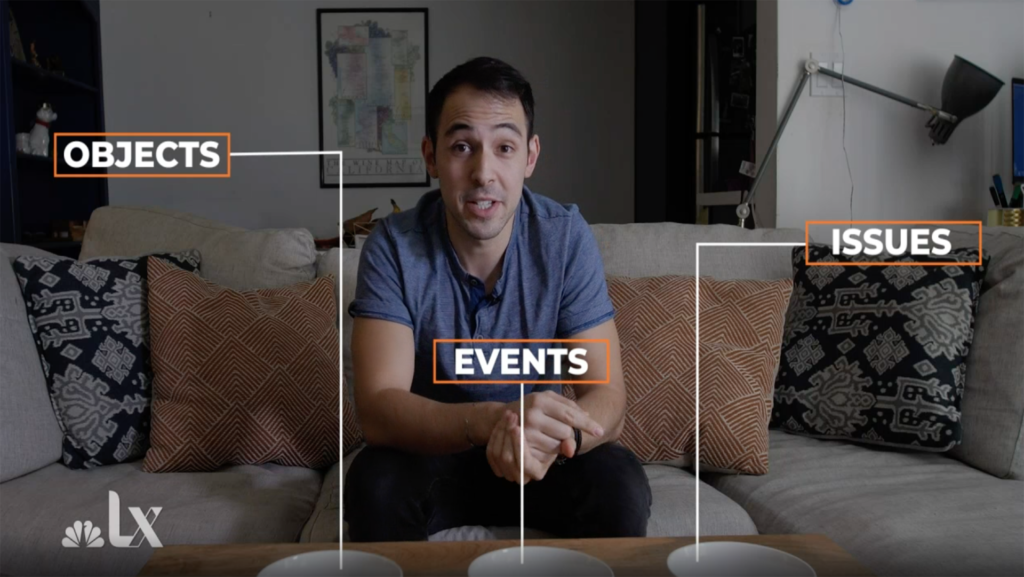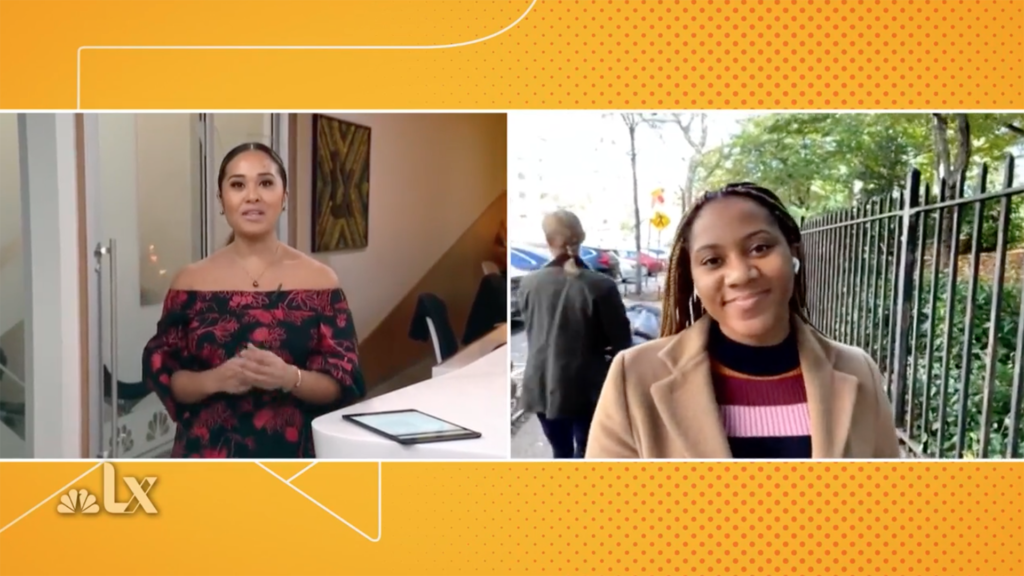
Okay, ready for your next assignment? Close your eyes and take one slip of paper from each of these three bowls. You now have in your hand three randomly selected topics — an event, an issue, and an object. Your job is to find the connections among them and weave that into an entertaining story about what you discovered and how you did it.
That’s the unlikely but entertaining premise of Connect the Dots, a four-part series that “dropped” this fall on NBCLX, the millennial-focused TV and streaming network that functions as an innovation lab for the NBC-owned stations. It’s one of the channel’s more recent experiments in re-writing the rules of conventional TV news, an unusual (but commendable) ambition for an operation that’s nested inside a traditional media company — and is deepening its connection with owned-station newsrooms.
When I asked SVP Meredith McGinn for her elevator pitch for NBCLX, which she oversees, she rattled it off so quickly and confidently that I was able to get off on the second floor. “LX is a startup in a big, reputable news organization,” she said. “And our goal is to innovate in storytelling. We’re looking to attract new audiences, and find new ways of telling great character stories that relate to broad audiences.”

Here at the Knight-Cronkite News Lab, we’ve been following NBCLX’s evolution for more than two years now, from a smattering of stories on YouTube and social media outlets featuring a small core group of “storytellers” to a fully formed linear and on-demand channel available online, on mobile, over the air in 46 markets, on select cable systems, and on the usual array of OTT services. On any given day, more than 50 people are working on content for LX, including contributors from other parts of the company like Fernando Hurtado, who created Connect the Dots.
“Journalistic scavenger hunt: that’s how I pitched it to my boss,” says Hurtado, who works on NBC’s digital innovation team and contributes regularly to LX. “The point of the series is to show how different aspects of our lives are interconnected. And not just that, but how your action in one aspect of your life could be impacting a totally different aspect.”
Hurtado gulped down his own Kool-Aid by reporting the first episode himself, looking for links between the World Series (event), access to water (issue), and microwaves (object). For the viewer, it’s a chance to see a reporter grinding out the work. “We noticed that you always get to see the finished product, but very rarely do you get to see how that sausage is made,” Hurtado says. “So we wanted to unveil the behind the scenes process of journalism — the ghosting, the emails that don’t get answered, the phone calls that you have to make to get your story — and really show that.”
“This was, ‘Let’s go shoot a pilot and see how it looks,’” says Matt Goldberg, the former KNBC assistant news director (and Cronkite School alum) who leads the team that launched and runs LX. “And then, when It came together, we realized not only was it an opportunity, but it was also an opportunity to leverage our stations, and that really is a great win for us.”
Watch Episode 2 of “Connect the Dots”
Proof of concept in hand, Hurtado recruited three talented digital journalists from the NBC stations for the other episodes: NBC 10 Boston’s Rob Michaelson (Boston Marathon, student loans, coffee); KTAZ Telemundo Arizona reporter Gabriela Martinez (Arizona State Fair, infertility, cacti); and WNBC’s Kay Angrum (Macy’s Thanksgiving Day Parade, gender equality, skyscrapers). As you probably noticed, the selection of events was market-specific in each case. Hurtado created a style guide for a consistent look and feel to the stories, and he edited two of the other episodes. (Michaelson shot, wrote, produced and edited his own contribution.)
More and more, NBCLX is connecting the dots with the stations, not just as distribution platforms but as additional sources of content, including hard news — all in the LX style, of course. “The team has been able to incorporate more of our storytellers from the owned stations in day and date stories,” McGinn says. “The team has done a great job over the last six to 12 months expanding the reach of the network and really tapping into the hundreds of journalists we have across the division. And that’s been an evolution.”
That has helped NBCLX double down on live reporting over the past year, not just in its six hours a day of regularly scheduled live programming but in extended coverage of milestones like Earth Day or the Mars landing. “It’s a brand of live, it’s a brand of depth,” says Goldberg. (The commitment to in-depth storytelling became literal when LX went live from the ocean floor off Florida for Earth Day.) Another hallmark: extended coverage of signature issues like climate change and racial justice. On October 4, LX’s 6 p.m. live show spent 17 ½ minutes in the first block covering the Southern California oil spill. “It’s live TV done in our brand,” Goldberg says.

But the growing emphasis on live coverage hasn’t crowded out highly crafted long-form journalism — the kind of enduring (the cliché is “long tail”) content well suited to an on-demand streaming experience. Case in point: Dying to be Wrong, a four-part docu-series released last month. Storyteller Cody Broadway returned to his hometown, San Angelo, Texas, to report on the impact of the pandemic and how COVID misinformation has divided the town even as the numbers of cases and deaths climbed. “The numbers were wrong is one misconception that I saw,” Broadway says. “And then the other was that people really weren’t dying.”
Watch Episode 1 of “Dying to be Wrong”
Despite his connection to the city, where he even worked as a news director, Broadway kept himself out of the documentary, letting his characters — the city official who keeps pandemic statistics, a funeral director, a local cleric, the mayor, an editor, about two dozen residents altogether — speak for themselves. (He gets more personal in an accompanying podcast.) “There was one way that I could tell it, like ‘Come along, I’m going to take you on this journey back to my hometown,’” Broadway says. “But I felt like this wasn’t the right type of story to tell that way, that this was a story of voices of this community. And I didn’t want to overshadow any of that.” Broadway’s approach, which he calls “cinematic journalism,” is noticeably different from the highly experiential reporter involvement of Connect the Dots. In the research and development lab culture of LX, there’s room for both. “Everyone’s got a different style on the storyteller team,” Broadway says, “and that’s what I love.”

Coming early in 2022 to NBCLX: fan controlled football. “This is a startup league that’s like Madden meets a real live football game, where you can be a fan of a team, you join a team, you commit to it, you can watch their games and the live play on NBCLX,” McGinn says. “And through an app, you can actually call plays for the team to run. So it was completely on brand for us and in line with what we’re trying to do every day — innovate in a traditional space. This league is doing that with football.”
The storytellers and their bosses are gratified to see some results of their experiments percolating across the NBC stations. “We’re always looking at ways to collaborate with all the NBC owned stations and spread the wealth and the experiences to get a little bit of that NBCLX DNA in those stations,” Hurtado says. “There is this really nice infusion of the voice of LX that I am starting to see across the stations, which is really exciting.”

“No matter what your title is, or what equipment you have, you can tell these types of stories,” Broadway says. “What I hope happens in other markets is that we can take this concept and what we’re doing and spread it throughout the entire NBC owned and operated stations, to really kind of get that fire of storytelling, that passion of good storytelling.”
“I think [given] the success we’ve had in long form, many of our stations have decided to let stories breathe more, lead with an investigative piece,” Goldberg says. “And then even stylistically, if you look at our set, and how we don’t have a traditional desk, taking away those barriers as our stations refresh their sets and come up with different ways to tell stories, they’re leaning in on what we’ve learned.”

“We always talked about it being an R & D lab,” McGinn says. “That’s what the business is. And of course, we have to get viewership and we have to make money. But we want to be able to develop ideas and hit some great new forms of storytelling that can then flow out to the stations.”
Unfettered by the normal constraints of locked-down formats and long-established audience expectations, and relatively free of ratings pressure (at least for now), the people of NBCLX know how lucky they are, and they are taking full advantage of the opportunity to innovate, iterate, and evolve. “Like any startup, there are learnings every day, every week, every month,” Goldberg says.
Do you have an R & D lab of your own?
Get the Lab Report: The most important stories delivered to your inbox